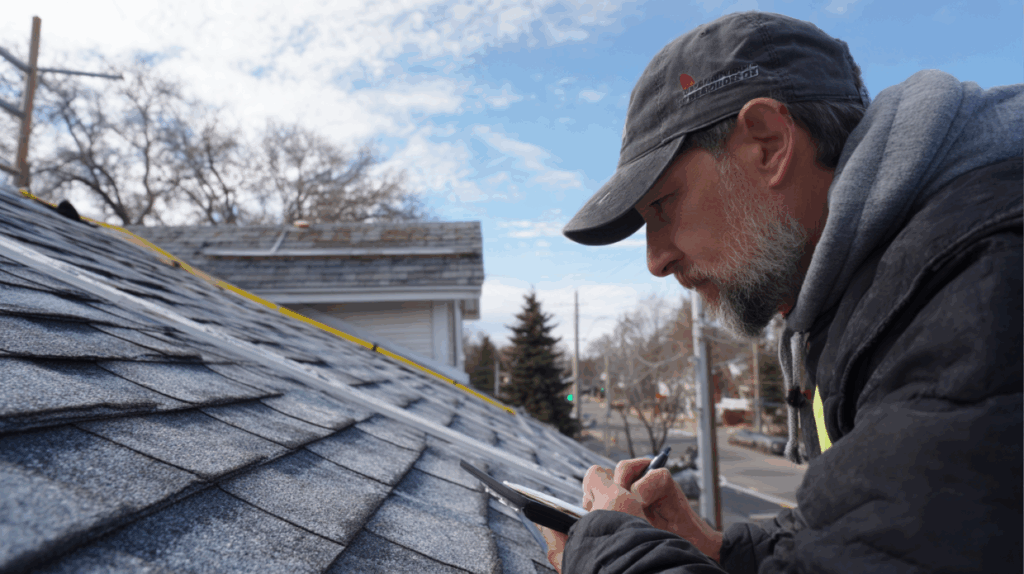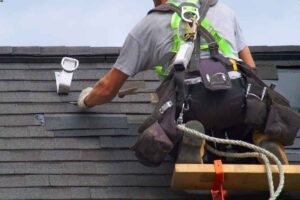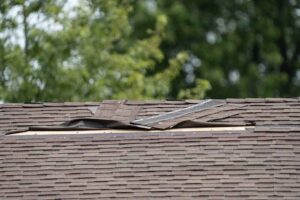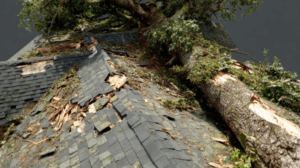Spring in the Northern Sandhills has a way of keeping homeowners guessing. One day the air feels soft and warm, the next, thunderheads roll in like a freight train from nowhere. If you’ve lived here long enough, you know those bright Carolina mornings can end in blinding rain, pounding hail, and winds strong enough to shake the house.
For most of us, those storms are just another part of life in North Carolina. But for your roof? They’re a full-blown endurance test. The combination of high winds, driving rain, and sharp hailstones can tear through weak spots in a matter of minutes.
The good news: you can prepare for it. A little storm-proofing before the season hits can mean the difference between a few loose shingles and a major insurance claim. Let’s walk through how to get your roof ready for the unpredictable punch of Sandhills spring storms—before the clouds start to build.
Why Sandhills Roofs Take a Beating
The Northern Sandhills region has its own unique weather patterns. The mix of warm, humid Gulf air and cold fronts sweeping down from the mountains creates prime conditions for intense thunderstorms. The storms may not last long, but they make up for it in power—wind gusts over 60 mph aren’t uncommon, and hail is practically a springtime tradition.
Roofs here face three major threats during storm season:
- Wind uplift, which can rip shingles right off or loosen flashing around chimneys and vents.
- Impact damage from hail or falling branches.
- Water intrusion, especially where seals or drainage systems have weakened over time.
Even a small breach can let water travel far under the surface, leading to leaks, rot, and mold long after the sky clears. That’s why proactive storm-proofing isn’t just smart—it’s necessary.

Step 1: Start with a Roof Inspection
Before the first rumble of thunder, your best defense is knowing the condition of your roof. Many homeowners assume their roof is fine because it “looks okay” from the ground. But the real trouble often hides where you can’t see it—under lifted shingles, cracked flashing, or worn sealant around penetrations.
A professional roof inspection pinpoints those weak spots before they turn into leaks. A trained roofer can spot things like:
- Hairline cracks from last year’s hailstorm
- Loose or missing shingles from winter wind
- Deteriorated caulking around vents, chimneys, or skylights
- Gutter buildup that could block runoff during heavy rain
Catching those issues early allows for small, affordable fixes instead of emergency repairs during a downpour.
Step 2: Reinforce What’s Already There
Storm-proofing isn’t just about replacing what’s broken—it’s about strengthening what’s still working. Even a roof in decent condition can benefit from reinforcements that help it handle the next big squall.
Consider these upgrades:
- Sealant touch-ups: A roofer can reseal vulnerable areas like flashing, vents, and nail heads to prevent leaks.
- Shingle reinforcement: Applying roofing adhesive under loose edges helps prevent wind uplift.
- Hurricane clips or fasteners: These secure the roof decking to rafters, providing extra stability in high winds.
- Gutter cleaning and anchoring: Clean, firmly attached gutters prevent overflow and water damage during heavy rainfall.
- Downspout extensions: Directing water away from the foundation keeps your home’s base dry and stable.
These aren’t major overhauls—they’re simple steps that add a big layer of protection. Think of them as the tune-up your roof needs before storm season really hits.
Step 3: Protect Against Hail Damage
Hailstorms are one of the biggest culprits behind roof damage in the Sandhills. Hailstones can crack shingles, expose underlayment, and weaken the roof’s ability to repel water. While you can’t stop hail from falling, you can make sure your roof is ready to take the hit.
If your current shingles are nearing end-of-life, talk to your roofer about impact-resistant materials. Class 4 shingles, for example, are designed to withstand the impact of large hailstones without cracking. They might cost a bit more upfront, but they last longer and can lower insurance premiums in some cases.
You can also:
- Trim back tree limbs that hang over your roof—falling branches during hailstorms cause major damage.
- Install protective guards over vulnerable areas like skylights.
- Check that attic insulation is in good shape to minimize temperature swings that can worsen shingle brittleness.
A roof built to absorb impact instead of shatter will save you a lot of trouble—and money—once those ice pellets start falling.
Step 4: Check Your Roof Flashing
Flashing is one of those small details that makes or breaks your roof’s performance. It’s the metal or rubber material that seals gaps around chimneys, skylights, and roof valleys. When storms roll in, these are the first places water tries to get in.
High winds can lift or bend flashing, and hail can crack the sealant holding it down. Once that happens, even light rain can work its way inside.
During a pre-season inspection, a professional should check:
- Chimney flashing for cracks or rust
- Valley flashing for lifted edges
- Vent boots for dry rot or holes
- Skylight seals for brittleness
Fixing flashing issues now keeps water out when it matters most—and it’s one of the simplest, most effective forms of storm-proofing you can do.

Step 5: Keep the Water Moving
Rain is only a problem when it has nowhere to go. Proper drainage is key to storm survival. When gutters clog or downspouts disconnect, water backs up under the roofline and seeps into the fascia or walls.
Before storm season, make sure your gutters are free of debris and securely fastened. Check that downspouts extend at least four feet from your foundation. You can even install gutter guards to keep leaves and pine needles from piling up during windy weather.
If your home has low-slope or flat sections, make sure those drains and scuppers are clear too—standing water can degrade roofing materials fast in warm spring weather.
Step 6: Plan for the Aftermath
Even the best-prepared homes can take a hit during severe storms. Knowing what to do afterward can prevent small damage from turning into long-term problems.
After a major storm passes, do a quick walk-around inspection from the ground. Look for missing shingles, sagging gutters, or debris piled on the roof. Inside, check your ceilings and attic for new stains or damp spots.
If you suspect damage, call a trusted local roofer like Red Wolf Roofing right away. Avoid climbing up yourself—it’s not worth the risk, especially if the roof is wet or unstable. A professional can safely document damage, provide photos for insurance, and get you a clear repair estimate fast.
The Pain Points Homeowners Face
For many Sandhills homeowners, roof maintenance falls into the “out of sight, out of mind” category—until the first leak. But the real pain comes after the storm: dealing with insurance, water damage, and long waits for repair crews who are already booked solid.
Here’s what proactive storm-proofing helps you avoid:
- Emergency repairs in the middle of storm season
- Hidden leaks that cause interior damage months later
- Rising repair costs due to worsening wear
- Insurance claim disputes over pre-existing damage
By scheduling an inspection before storm season, you stay one step ahead. You’ll know your roof’s condition, have documentation for future claims, and gain peace of mind knowing your home’s first line of defense is ready for battle.
Why Choose Red Wolf Roofing
When it comes to storm-proofing, experience matters. Red Wolf Roofing understands the challenges of Northern Sandhills weather because they live and work here too. Their team specializes in spotting the small vulnerabilities that most people miss—before they become big problems.
They offer comprehensive inspections, straightforward repair quotes, and quality craftsmanship designed to last through wind, rain, and hail. From sealing flashing to replacing impact-resistant shingles, every project is handled with care and local expertise.
Red Wolf Roofing doesn’t just fix roofs—they help homeowners protect their homes, their families, and their sense of security.
Beat the Storms Before They Beat You
Every spring, the Sandhills sky reminds us how powerful nature can be. Thunder rolls, hail hammers down, and the wind howls through the trees. But with a strong, storm-ready roof overhead, you can watch it all knowing your home is protected.
Now’s the time to act—before the first thunderhead builds on the horizon. Schedule a storm-proofing inspection and repair quote with Red Wolf Roofing in North Carolina. Their expert team will evaluate your roof, reinforce its weak points, and make sure it’s ready for whatever spring throws your way.
Because when the next big storm hits, peace of mind isn’t just nice to have—it’s priceless.



